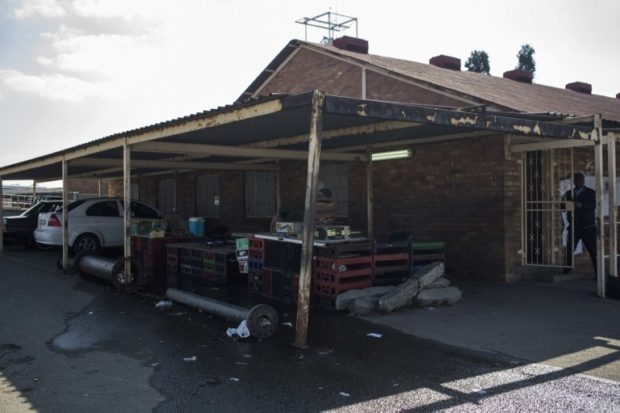
A picture taken on June 14, 2018 shows the National union of Mineworkers (NUM) Office at the Evander Gold Mine main site in Mpumalanga. AFP
Evander, South Africa — About 100 miners dressed in high-visibility workwear, balaclavas, gloves and boots line up against a shipping container that serves as a makeshift office at the Evander gold mine.
They wait forlornly in the brisk Highveld winter. Their hope is to get work.
This is the bitter daily routine for men and women recently made redundant from full-time employment at the mine, 100 kilometers (60 miles) east of Johannesburg.
“We have been coming here every morning for the last three months from 5:00 am, waiting for the employer to call our names. But no-one comes. We carry our certificates and work papers each day,” Andile Skweyiya, 43, told AFP.
“There are no work opportunities anywhere for most of us,” Skweyiya said. “If you don’t find work, you have to go rob people to eat, and I don’t want to do that.”
In May, mine owner Pan African resources let go 1,710 of 1,800 workers at the Evander Gold operation in Mpumalanga province, saying the site would undergo “care and maintenance” but that some surface work would continue.
A small number of miners were later given short-term contracts, and others have since waited outside the mine hoping to also get piecemeal work.
The mining sector once provided permanent work for many thousands of migrant workers.
Now, the industry has waned to the point that “you can be retrenched (made redundant) anytime,” mining analyst Mamokgethi Molopyane told AFP.
On Tuesday, Gold Fields — one of South Africa’s most venerable miners — announced plans to slash 1,100 jobs, or nearly a third of the full-time workforce, at its loss-making South Deep unit.
‘A huge loss of jobs’
At their peak in the late 1980s, South Africa’s mines employed 760,000 people, contributed 21 percent to GDP, according to government figures.
Due to mechanisation and as deposits become harder to access profitably, the number has fallen drastically.
Just over 460,000 people worked in the mines in 2017, about 112,200 of which were gold miners.
Another 50,000 jobs were lost in the first quarter of 2018 compared to 2017, with the sector’s contribution to GDP now below 10 percent.
Once powerful unions have also declined.
Membership at South Africa’s National Union of Mineworkers (NUM), co-founded by now president Cyril Ramaphosa, has shrunk from about 340,000 in 1986 to 187,000.
Ramaphosa, who came to power in February, faces the formidable challenge of tackling record national unemployment levels of 27 percent, with youth unemployment estimated at over 50 percent.
Mining has played a central role in shaping South Africa’s history since diamonds were discovered in Kimberley in 1868 and the Witwatersrand gold rush of 1886 that led to the establishment of Johannesburg.
But now South Africa must look elsewhere for desperately-needed employment.
“If we take a longer-term look at mining, the fact of the matter is that it is going to lose a lot of jobs,” labour economist Andrew Levy said, adding that mining had shifted from being labour intensive to capital intensive.
“There is going to be a huge loss of jobs there which will never be replaced.”
All over by 2033?
Sipho Pityana, head of South African mining giant AngloGold Ashanti, last month admitted gold was “a sunset industry”.
A third of South Africa’s gold mines are unprofitable according to the Minerals Council.
It estimates that the gold industry will see a sharp decline in production by 2019-20, with reserves exhausted as soon as 2033.
The biggest problem is that mines are having to delve ever deeper for gold, placing them at a disadvantage against open mines elsewhere in the world.
Some reach four kilometres (2.5 miles) below the surface, requiring heavy investment in machinery to get men to the seam and haul out the spoil.
“Our gold mines are the deepest in the world, working places are further and further away from infrastructure, costs have spiralled,” Minerals Council spokeswoman Charmane Russell said.
With gold losing its shine, short-term labour agreements have left workers like Gugu Malatse, 33, earning far less money than when permanent employees.
“Underground we worked from 7:00am until 12 midday and I earned 8 to 9,000 rand a month ($565 to $635) a month… Now I get only up to 2,300 rand,” Malatse told AFP.
“We are being cheated and condemned to poverty,” Malatse added.
Others like the eSwatini (Swaziland) national, Vuyiswa Shlungunyana, 32, said they had not only lost their income but have also been evicted from the mines’ hostel.
For Ramaphosa, the master negotiator, a new deal between mining companies, government and unions is a priority to attract foreign investment and retain what jobs can be saved.
“We want this mining charter to be finalised so that we can reposition this industry,” Ramaphosa said at the recent NUM conference. /kga

